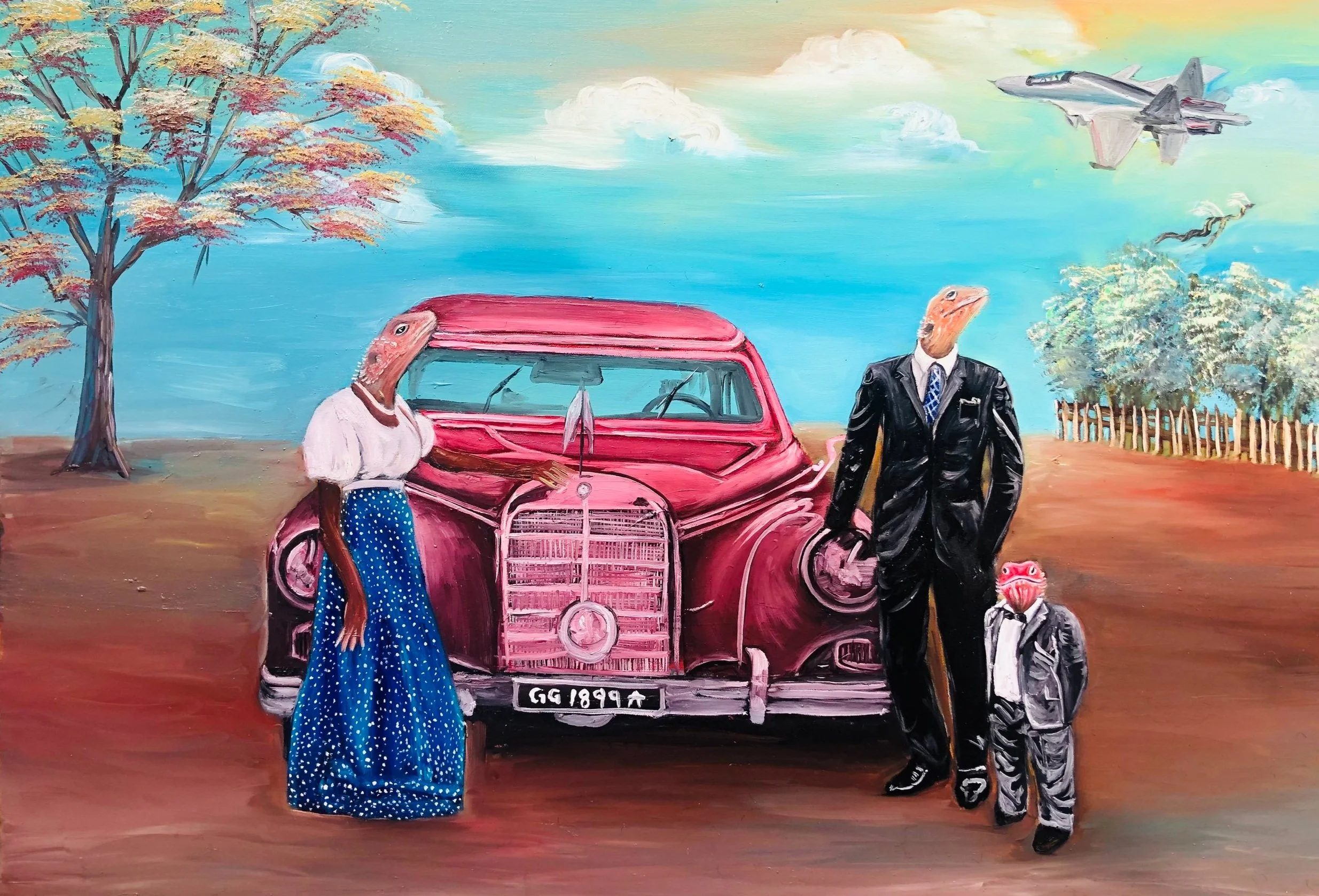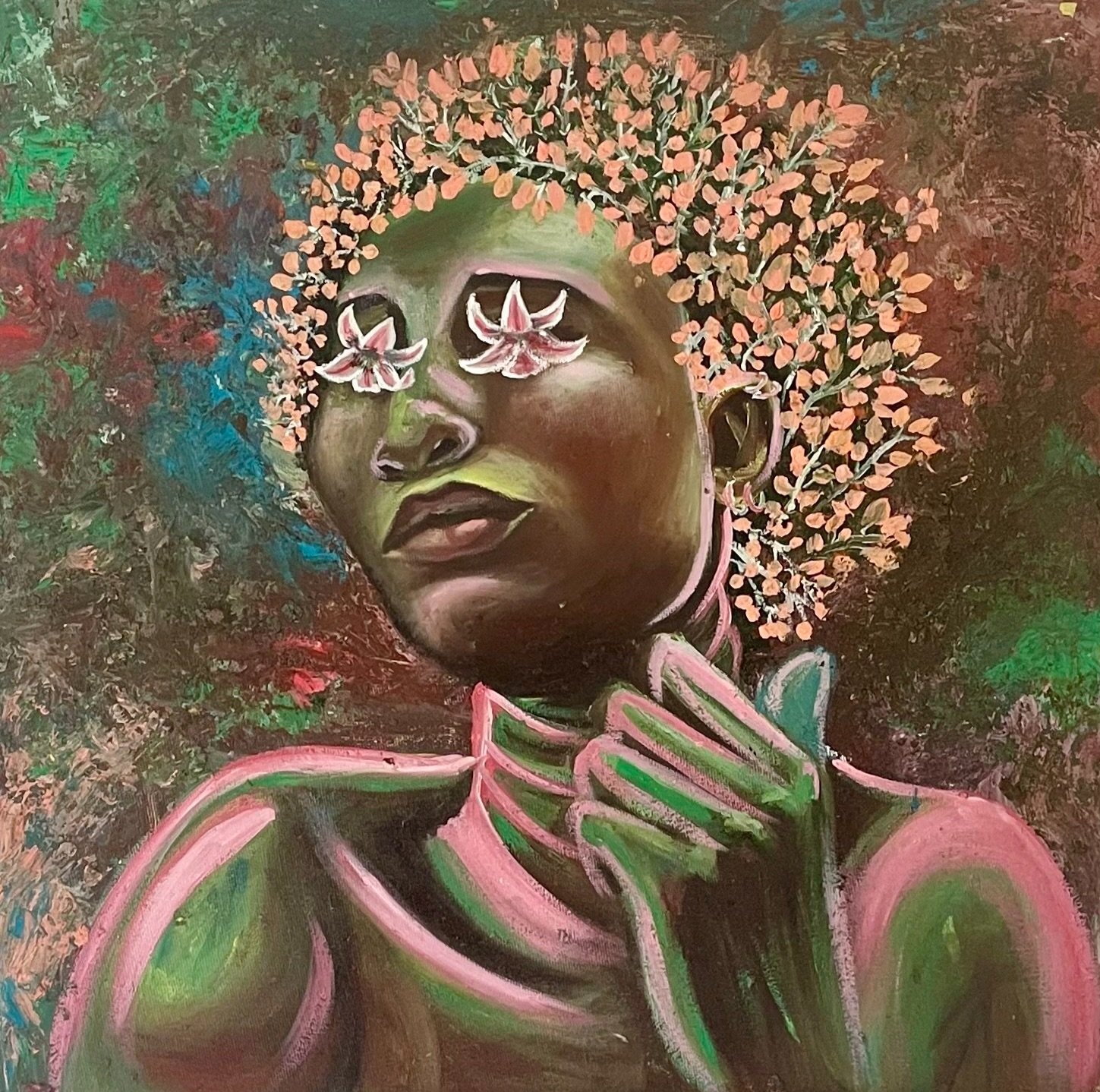10 Questions with Sarah Owusu-Ansah
Sarah Owusu-Ansah is an artist from Accra, Ghana, currently living and working in Karlsruhe, Germany. She has a Bachelor of Art degree from the Kwame Nkrumah University of Science and Technology in Ghana, and a Postgraduate degree from the State Academy of Arts in Karlsruhe, Germany. Art has always been her way of dealing with tough times and depression. Her dad was her inspiration for getting into art, and even though he couldn't continue due to his health. Sarah uses her art to stay connected with him and process his absence. It's also a way for the artist to introduce others to her interests and create unique experiences.
Sarah Owusu-Ansah - Portrait
ARTIST STATEMENT
Her art is influenced by her daily interests, from her fascination with sci-fi stories and horror movies, to her constantly changing genre in music. Films like Chronicles of Narnia and Alice in Wonderland were a long-time fascination for her as a child, and she has been enchanted with the possibility of multiple realities existing in our natural world. Her art practice is a vehicle for arriving at these different realities. The images she creates are dependent on what phase she is going through in her life and her environment at that moment. Her thick application of paint gives the image the space to live freely outside the picture plane. She believes the image also commands its own presence when the paint seems to reach out from the surface it's been confined to.
Also, it is a subconscious daubing of the images from her mind to the canvas - before she can lose the memory of it. She likes to paint on any material surface she finds. She is particularly drawn to wood, but for no apparent reason. Perhaps the physical features, such as the thickness and surface, spark her imagination more than most materials do. She is able to cover a variety of topics when she works on themes. This also gives her the freedom to share her daydreams with the world without using many words.
Agama “Family Photo”, Oil on canvas, 39.5” x 27.5” © Sarah Owusu-Ansah
INTERVIEW
When and how did you start getting involved with visual arts?
I started making art long before I properly understood what art is. I liked to make drawings, cartoons, and books I liked, and also because it is something I shared with my dad. We did not always get along, but it was one thing we both loved doing.
What, for you, is the most enjoyable part of your art?
Most of my art series involves interacting with people and involving their experiences in my work. The process of creating from others and my experience is the most fulfilling part of making art. Also, most people feel happy about being part of my work, and that is one of my main drives.
Essence (Second from the Origin Series), Oil on Canvas, 5 x 7 feet © Sarah Owusu-Ansah
Let's talk about your work. You predominantly work with oil painting, and as you mention in your statement, you link to paint on any material surface you find. How do you choose the mediums and surfaces to work with for a specific project?
A usual part of my day involves taking a walk around the streets and collecting materials that have been discarded as "irrelevant" and use them in my work. I often do not have a specific project in mind when collecting. If I have a project at hand, I look at the materials I have available, and find the one which best suits the idea of the project. I often work with oil because I am more comfortable controlling the medium, and it allows me to work at my own pace. Otherwise, I like to experiment with different techniques and media depending on the specific theme I am working with and the desired effect.
Where do you find inspiration for your work and what is your creative process like?
Anytime I develop an interest in any topic, I try to create an art piece relating to that topic. Therefore, I am usually inspired by themes of science fiction, dreams, ethics, and society. I am also influenced by artists like Nadia Waheed and Bruce Nauman. Each creative process is different. In my current series, "Misfits," I make A3 drawings from mugshot photos taken from family and friends. My drawings depict monochromatic figures with coloured outlines. I started this by asking people to take "mugshot" photos. Then through the image transfer process, I print and transfer the images onto cardboard. I then ask the people for anything people consider "weird" or "unusual" about themselves that they are not ashamed of and then make it their crime. Then finally, I create a police report and a criminal profile for each person. The most enjoyable part of this process is getting people to openly talk about their weirdness and "flaws" and, in the end, feel good about sharing it.
After Earth II, Oil on canvas, 20 x 20 inch, 2021 © Sarah Owusu-Ansah
After Earth III, Oil on canvas, 20 x 20 inch, 2021 © Sarah Owusu-Ansah
Why do you use this visual language? And how has it evolved over the years?
I use visual language mostly because that is the main way I consume information. Over the years, I have tried to combine it with sound but did not have the freedom and space to explore it further. Despite that, I have tried to involve various visual languages like print, drawing, and photography.
What do you hope that the public takes away from your work?
Considering my personal struggles with depression and loss, in the end, I want people to feel good about themselves, even if it is just for a brief moment. I want to introduce them to new interests they can love, and I want them to be able to self-reflect and see how in some way, everything and everyone is connected.
Is there anything else you would like to experiment with?
Where to start? I would like to experiment with sound, photography, and digital media. I would also like to be part of a public project which gives people a chance to be part of something other than themselves.
Gone but not forgotten, Oil and Soil on canvas, 84” x 54” © Sarah Owusu-Ansah
What are you working on now, and what are your plans for the future in terms of new projects?
Currently, I am working on two series. "Misfits," as I mentioned before, and "Spaces Fragmented." They both involve playing around with the ideas of photography, print, and drawing. In Misfits, I explore these ideas through the figures, and in Spaces Fragmented, I explore these ideas through structures and streets. I create new images by transferring printed photos unto a surface, creating a transparent and layered surface. Then I connect lines to create new images.
Finally, do you have any upcoming shows or collaborations you are looking forward to?
I would like to have my solo show by the end of this year or really next year, but that is just wishful thinking.
Currently, I have applied for some open calls for group exhibitions, which I very much look forward to being a part of.





















